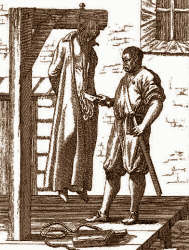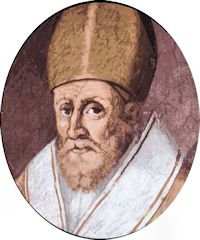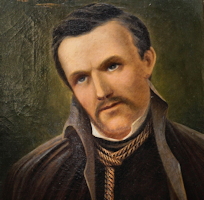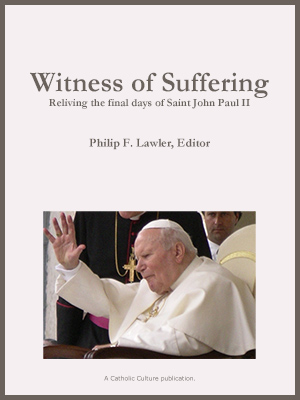Lent: March 10th
Thursday of the First Week of Lent; St. John Ogilvie, priest and martyr (Feast, Scotland)
Other Commemorations: St. John Ogilvie, Priest & Martyr (RM, Feast, Scotland); St. Marie-Eugenie de Jesus (RM); St. Simplicius, Pope (RM)
» Enjoy our Liturgical Seasons series of e-books!
In certain ways the Lenten Christian is like the Jew in exile. He is still exposed to the attacks of the enemies. Lent, like the exile in Babylon, is a time of cleansing. It intends to create in us a greater desire and longing for deliverance which God has promised us through our savior Jesus Christ. All the chants and prayers in today's Mass are urgent pleas for God's mercy and help.
The Church has fittingly assumed the prayer of Esther as her own today. Like the Jews of old, she finds her people in many countries fighting against a well-organized plan of a persecution and extermination, more terrible than the one the Jews had to face. She is undergoing this trial to show her fidelity to Christ, and to plead for the salvation of all men. —St. Andrew Bible Missal
Today Catholics in Scotland celebrate the feast of St. John Ogilvie, who was educated as a Calvinist and was received into the Church at Louvain by Father Cornelius a Lapide. After becoming a Jesuit at the age of seventeen, he was ordained to the priesthood in 1613, and at his own request was sent on a perilous Scottish mission. He was eventually betrayed, but during a long imprisonment, no tortures could force him to name any fellow Catholics. Though his courage was admired by the judges he was condemned as a traitor and hanged at Glasgow. The customary beheading and quartering were omitted owing to undisguised popular sympathy, and his body was hurriedly buried in the churchyard of Glasgow cathedral.
The Roman Martyrology honors St. Marie-Eugenie de Jesus today. She was a religious sister who founded the Congregation of the Religious of the Assumption in 1839. On June 3, 2007, she was canonized in Vatican City by Pope Benedict XVI.
March 10 is nine days before the Solemnity of St. Joseph, and the day to begin a novena to St. Joseph for his feast day.
Meditation—Confidence and Union with God in Temptation
Nothing is more efficacious against temptation than the remembrance of the Cross of Jesus. What did Christ come to do here below if not to "destroy the works of the devil"? And how has He destroyed them, how has He "cast out" the devil, as He Himself says, if not by His death upon the Cross?
Let us then lean by faith upon the cross of Christ Jesus, as our baptism gives us the right to do. The virtue of the cross is not exhausted. In baptism we were marked with the seal of the cross, we became members of Christ, enlightened by His light, and partakers of His life and of the salvation He brings to us. Hence, united to Him, whom shall we fear? Dominus illuminatio mea et salus mea; quern timebo? Let us say to ourselves: "He hath given His angels charge over thee to keep thee in all thy ways."
"Because he hoped in Me (says the Lord) I will deliver him; I am with him in tribulation, I will deliver him, and I will glorify him. I will fill him with length of days, and I will show him My salvation."
—Excerpted from Christ the Life of the Soul, Dom Marmion
St. John Ogilvie
Born in 1579 at Drum, Keith, Scotland. Walter Ogilvie was a Scottish noble who raised his son John in the state religion of Scotland, Calvinism. John converted to Catholicism at the age of 17 in Louvain, Belgium. Blessed John joined the Jesuits soon after in 1597, and was ordained in Paris in 1610. He was sent to work in Rouen, France.
 He repeatedly requested assignment to Scotland where wholesale massacres of Catholics had taken place, but by this point the hunters were searching more for priests than for those who attended Mass.
He repeatedly requested assignment to Scotland where wholesale massacres of Catholics had taken place, but by this point the hunters were searching more for priests than for those who attended Mass.
The Jesuits were determined to minister to the oppressed Catholic laity. When captured, they were tortured for information, then hanged, drawn, and quartered.
Ogilvie's request was granted, and he returned to Scotland in November 1613. He worked as an underground missionary in Edinburgh and Glasgow, dodging the Queen's priest-hunters, disguising himself as a soldier named Watson. After 11 months in the field, John was betrayed, imprisoned, interrogated, then tortured for the names of active Catholics. He suffered in silence.
He is the Church's only officially recorded Scottish martyr. He died hanged on March 10, 1615 in Glasgow, Scotland and was canonized by Paul VI on October 17, 1976.
Highlights and Things to Do:
- Read more about St. John Ogilvie:
St. Marie Eugenie of Jesus
 Anne Marie Eugenie was born in 1817 in Metz after Napoleon's complete defeat and the restoration of the Monarchy. She belonged to a non-believing and financially comfortable family and it seemed unlikely that she would trace a new spiritual path across the Church of France.
Anne Marie Eugenie was born in 1817 in Metz after Napoleon's complete defeat and the restoration of the Monarchy. She belonged to a non-believing and financially comfortable family and it seemed unlikely that she would trace a new spiritual path across the Church of France.
Her father, follower of Voltaire and a liberal, was making his fortune in the banking world and in politics. Eugenie's mother provided the sensitive Eugenie with an education, which strengthened her character and gave her a strong sense of duty. Family life developed her intellectual curiosity and a romantic spirit, an interest in social questions and a broad world view.
Like her contemporary, George Sand, Anne Eugenie went to Mass on feast days and received the Sacraments of initiation, as was the custom but without any real commitment. However, her First Communion was a great mystical experience that foretold the secret of her future. She did not grasp its prophetic meaning until much later when she recognized it as her path towards total belonging to Jesus Christ and the Church.
Her youth was happy but not without suffering. She was affected when still a child by the death of an elder brother and a baby sister. Her health was delicate and a fall from a horse left serious consequences. Eugenie was mature for her age and learnt how to hide her feelings and to face up to events. Later, after a prosperous period for her father, she experienced the failure of his banks, the misunderstanding and eventual separation of her parents and the loss of all security. She had to leave her family home and go to Paris while Louis, closest to her in age and faithful companion went to live with their father. Eugenie went to Paris with the mother she adored, only to see her die from cholera after a few hours of illness, leaving her alone at the age of fifteen in a society that was worldly and superficial. Searching in anguish and almost desperate for the truth, she arrived at her conversion thirsty for the Absolute and open to the Transcendent.
When she was nineteen, Anne Eugenie attended the Lenten Conferences at Notre Dame in Paris, preached by the young Abbe Lacordaire, already well-known for his talent as orator. Lacordaire was a former disciple of Lamennais—haunted by the vision of a renewed Church with a special place in the world. He understood his time and wanted to change it. He understood young people, their questions and their desires, their idealism and their ignorance of both Christ and the Church. His words touched Eugenie's heart, answered her many questions, and aroused her generosity. Eugenie envisaged Christ as the universal liberator and his kingdom on earth established as a peaceful and just society. I was truly converted, she wrote, and I was seized by a longing to devote all my strength or rather all my weakness to the Church which, from that moment, I saw as alone holding the key to the knowledge and achievement of all that is good.
Just at this time, another preacher, also a former disciple of Lamennais, appeared on the scene. In the confessional, Father Combalot recognized that he had encountered a chosen soul who was designated to be the foundress of the Congregation he had dreamt of for a long time. He persuaded Eugenie to undertake his work by insisting that this Congregation was willed by God who had chosen her to establish it. He convinced her that only by education could she evangelize minds, make families truly Christian and thus transform the society of her time. Anne Eugenie accepted the project as God's will for her and allowed herself to be guided by the Abbe Combalot.
At twenty-two, Marie Eugenie became foundress of the Religious of the Assumption, dedicated to consecrate their whole life and strength to extending the Kingdom of Christ in themselves and in the world. In 1839, Mademoiselle Eugenie Milleret, with two other young women, began a life of prayer and study in a flat at rue Ferou near the church of St. Sulpice in Paris. In 1841, under the patronage of Madame de Chateaubriand, Lacordaire, Montalembert and their friends, the sisters opened their first school. In a relatively short time there were sixteen sisters of four nationalities in the community.
Marie Eugenie and the first sisters wanted to link the ancient and the new—to unite the past treasures of the Church's spirituality and wisdom with a type of religious life and education able to satisfy the demands of modern minds. It was a matter of respecting the values of the period and at the same time, making the Gospel values penetrate the rising culture of a new industrial and scientific era. The spirituality of the Congregation, centered on Christ and the Incarnation, was both deeply contemplative and dedicated to apostolic action. It was a life given to the search for God and the love and service of others.
Marie Eugenie's long life covered almost the whole of the 19th century. She loved her times passionately and took an active part in their history. Progressively, she channeled all her energy and gifts in tending and extending the Congregation, which became her life work. God gave her sisters and many friends. One of the first sisters was Irish, a mystic and her intimate friend whom she called at the end of her life, "half of myself." Kate O'Neill, called Mother Therese Emmanuel in religion, is considered as a co-foundress. Father Emmanuel d'Alzon, became Marie Eugenie's spiritual director soon after the foundation, was a father, brother or friend according to the seasons. In 1845, he founded the Augustinians of the Assumption and the two founders helped each other in a multitude of ways over a period of forty years. Both had a gift for friendship and they inspired many lay people to work with them and the Church. Together, as they followed Christ and labored with him, the religious and laity traced the path of the Assumption and took their place in the great cloud of witnesses.
In the last years of her life, Mother Marie Eugenie experienced a progressive physical weakening, which she lived in silence and humility—a life totally centered on Christ. She received the Eucharist for the last time on March 9, 1898 and on the 10th, she gently passed over to the Lord. She was beatified by Pope Paul VI on February 9, 1975 and canonized by Pope Benedict XVI on June 3, 2007 in Rome.
—© Libreria Editrice Vaticana
Highlights and Things to Do:
- Visit the Assumption Religious to learn more about St. Marie Eugenie.
- See also CatholicSaints.info
St. Simplicius
 Saint Simplicius was the ornament of the Roman clergy under Sts. Leo and Hilarius, and succeeded the latter in the pontificate in 468. He was raised by God to corn fort and support his Church amidst the greatest storms. All the provinces of the Western Empire, out of Italy, were fallen into the hands of barbarians.
Saint Simplicius was the ornament of the Roman clergy under Sts. Leo and Hilarius, and succeeded the latter in the pontificate in 468. He was raised by God to corn fort and support his Church amidst the greatest storms. All the provinces of the Western Empire, out of Italy, were fallen into the hands of barbarians.
The emperors for many years were rather shadows of power than sovereigns, and, in the eighth year of the pontificate of Simplicius, Rome itself fell a prey to foreigners. Italy, by oppressions and the ravages of barbarians, was left almost a desert without inhabitants; and the imperial armies consisted chiefly of barbarians, hired under the name of auxiliaries. These soon saw that their masters were in their power. The Heruli demanded one-third of the lands of Italy, and upon refusal chose for their leader Odoacer, one of the lowest extraction, but a resolute and intrepid man, who was proclaimed king of Rome in 476. He put to death Orestes, who was regent of the empire for his son Augustulus, whom the senate had advanced to the imperial throne. Odoacer spared the life of Augustulus, appointed him a salary of six thousand pounds of gold, and permitted him to live at full liberty near Naples.
Pope Simplicius was wholly taken up in comforting and relieving the afflicted, and in sowing the seeds of the Catholic faith among the barbarians.
The East gave his zeal no less employment and concern. Peter Cnapheus, a violent Eutychian, was made by the heretics Patriarch of Antioch; and Peter Mengus, one of the most profligate men, that of Alexandria. Acacius, the Patriarch of Constantinople, received the sentence of St. Simplicius against Cnapheus, but supported Mongus against him and the Catholic Church, and was a notorious changeling, double-dealer, and artful hypocrite, who often made religion serve his own private ends. St. Simplicius at length discovered his artifices and redoubled his zeal to maintain the holy faith, which he saw betrayed on every side, whilst the patriarchal sees of Alexandria and Antioch were occupied by furious wolves, and there was not one Catholic king in the whole world. The emperor measured everything by his passions and human views.
St. Simplicius, having sat fifteen years, eleven months, and six days, went to receive the reward of his labors in 483. He was buried in St. Peter's on the 2d of March.
—Excerpted from Lives of the Saints, by Alban Butler, Benziger Bros. ed. [1894]
Highlights and Things to Do:
- Learn more about Pope Simplicius:
- The Monophysite heresy maintained that Jesus Christ’s nature remains altogether divine and not human even though he has taken on an earthly and human body with its cycle of birth, life, and death. Monophysitism asserted that the person of Jesus Christ has only one, divine nature rather than the two natures, divine and human, that were established at the Council of Chalcedon in 451. Read a comprehensive essay on Monophysites and Monophysitism at New Advent.






